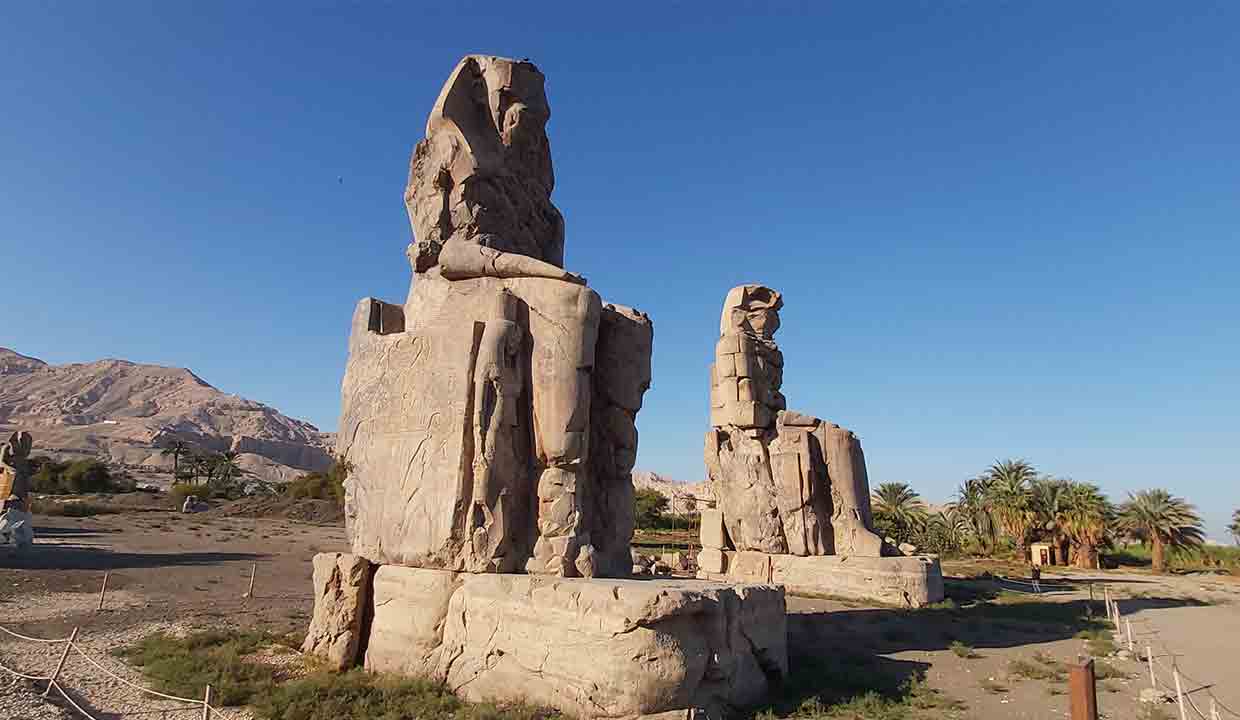Journey back in time with the Colossi of Memnon: two awe-inspiring statues guarding Egypt’s past. Experience history on a monumental scale and let your imagination soar!
Introduction
As dawn breaks over the Theban Necropolis, the Colossi of Memnon silently greet the rising sun, just as they have for over three millennia. These colossal statues of Pharaoh Amenhotep III stand as enduring sentinels of Egypt’s splendid past, captivating visitors with their sheer size and enigmatic history.
Origins of the Colossi
The Colossi of Memnon are twin stone statues crafted from blocks of quartzite sandstone. They depict Pharaoh Amenhotep III (1386–1353 BCE) seated on his throne, with hands resting on his knees, gazing eastwards towards the Nile River and the rising sun. Each statue towers about 18 meters (60 feet) above the ground, embodying the grandeur and authority of one of Egypt’s most powerful rulers.
Historical Significance
Amenhotep III’s Legacy:
Under Amenhotep III’s reign, Egypt experienced unprecedented prosperity and cultural renaissance. The Colossi were originally erected to guard the entrance to Amenhotep III’s mortuary temple – an architectural masterpiece that once graced the Theban Necropolis, albeit now largely ruined.
Temple of Amenhotep III:
The Mortuary Temple of Amenhotep III was the largest of its kind in the necropolis. Though little remains of the original structure, it was known for its architectural innovation and exquisite artwork, reflecting the zenith of the Egyptian empire’s might and cultural richness.
The Colossi Through the Ages
Over the centuries, the Colossi of Memnon have witnessed the rise and fall of empires, surviving natural disasters and human interventions. The statues acquired their name “Memnon” from the Greeks, who associated them with the mythical hero Memnon, son of the dawn goddess Eos.
The Colossi have also been subjects of fascination and reverence due to the “Vocal Memnon” phenomenon. Ancient travelers and writers documented that one of the statues emitted a mysterious sound at dawn, believed to be the voice of the oracle. Though the sound ceased after restoration work in the Roman era, the legends surrounding the “singing statue” continue to enthrall.
Visiting the Colossi
- Location: The statues are located on the West Bank of the Nile near the modern city of Luxor.
- Accessibility: The site is easily accessible by various means of transport from Luxor, and guided tours are frequently available.
- Best Time to Visit: Early morning or late afternoon visits are recommended to experience the site in cooler temperatures and softer light, perfect for photography and contemplation.
Conclusion
A journey to the Colossi of Memnon is a voyage through time, providing insights into the life and reign of Pharaoh Amenhotep III while allowing visitors to stand in the shadows of monumental art and history. As you gaze up at these colossal figures, let the whispers of the ancient stones tell you tales of glory, mystery, and the indomitable spirit of a civilization that continues to fascinate the world. Whether you’re a history buff, an art enthusiast, or a curious traveler, the Colossi of Memnon offer an experience that is timeless and unforgettable.
